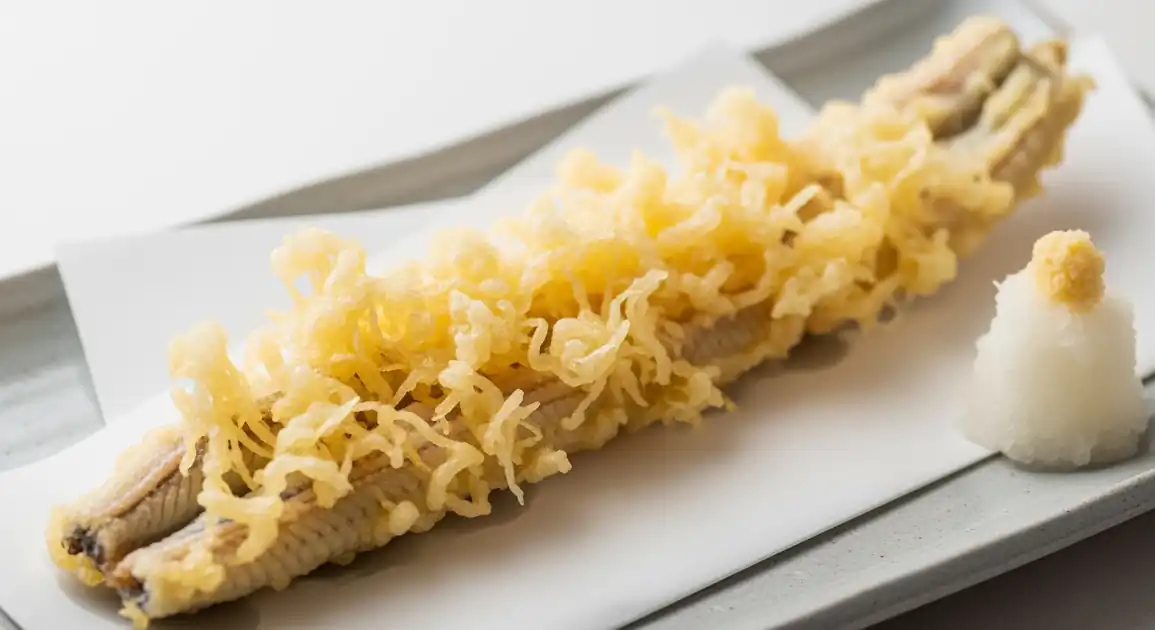Anago Tempura (Conger Eel Tempura)
穴子天ぷら

Description
Anago Tempura is available throughout Japan, especially in restaurants specializing in tempura or traditional Japanese cuisine ('washoku'). Quality varies, with dedicated tempura restaurants generally offering the best experience. It's particularly popular during its peak summer season.
Dietary Information
Serving information
Serving style
Served hot immediately after frying. Presented on tempura paper to absorb excess oil, often with grated daikon, ginger, lemon wedge, salt (sometimes flavored), and/or tentsuyu dipping sauce. In Tendon, served over rice with sauce.
Quick facts
Lunch: ~11 AM - 2:30 PM, Dinner: ~5 PM - 10 PM. Varies significantly by establishment.
Safety Tips
What to Look For
-
Fried fresh to order ('Age-tate')
Tempura quality diminishes rapidly after frying. Ensure it's cooked just before serving for optimal crispness and heat, which also ensures thorough cooking.
-
Light, crispy, pale golden batter
Indicates proper frying technique and temperature. Avoid thick, heavy, or dark brown batter, which suggests old oil or incorrect temperature.
-
Clean, clear frying oil
Good tempura shops change their oil frequently. Dark, murky, or smoking oil can impart off-flavors and indicates poor maintenance.
-
Specialty tempura restaurant or counter seating
Places specializing in tempura, especially those where you can watch the chef, usually maintain higher standards of freshness and technique.
-
Served piping hot
Ensures the food hasn't been sitting out and is at a safe temperature, crucial for enjoying the texture.
What to avoid
-
Pre-fried tempura sitting under heat lamps or at room temperature
Will be soggy and potentially unsafe if left out too long. Always insist on freshly fried.
-
Dark, greasy, or overly thick batter
Suggests problems with the oil, temperature, or batter recipe, leading to poor taste and texture.
-
Oil that smells burnt or rancid
A clear sign the oil is old and needs changing. This negatively impacts flavor and safety.
-
Unusually low prices for Anago Tempura
Anago can be expensive. Exceptionally cheap offerings might indicate lower quality eel or preparation standards.
Price information
Price range
Budget tips
- Ordering à la carte at a counter can be expensive; set menus ('teishoku') often offer better value.
- Soba/Udon shops provide a more casual and affordable way to try it.
- Lunch sets are usually cheaper than dinner courses at tempura restaurants.
Value indicators
- Freshly fried ('Age-tate').
- Light, crispy batter.
- Delicate, non-fishy flavor.
- Served at a specialty tempura restaurant.
- Generous portion size relative to price.
Where to Find This Dish
Specialty Tempura Restaurants ('Tempura-ya')
Found nationwide, varying from casual to high-end. Often have counter seating.
Signs reading 天ぷら or 天麩羅
Lunch, Dinner
Department Store Food Halls ('Depachika')
Upscale food basements sometimes have tempura counters or pre-packaged sets. Verify freshness.
Major department stores (Takashimaya, Mitsukoshi, Isetan)
Daytime (11 AM - 7 PM)
Traditional Markets
Some larger food markets might have stalls selling tempura items.
Fish markets (less common for prepared tempura), local food markets
Morning, Daytime
Vendor Tips
- Counter seating allows you to eat pieces immediately as they are fried.
- Observe the chef's technique and the condition of the oil.
- Ask for 'age-tate' (freshly fried) if ordering pre-made items.
How to Order
Regional Variations
-
Anago Tendon
(穴子天丼)
A large piece (or pieces) of Anago Tempura served over a bowl of rice ('donburi'), typically drizzled with a sweet soy-based sauce ('tare').
-
Anago Ten-Soba / Ten-Udon
(穴子天そば / 穴子天うどん)
Anago Tempura served on top of or alongside hot or cold Soba (buckwheat) or Udon (wheat) noodles.
-
Anago Tempura Set
(穴子天ぷら定食)
Served as part of a set meal ('teishoku') which usually includes rice, miso soup, pickles, and possibly other tempura items.
-
Anago Tempura à la Carte
(穴子天ぷら 単品)
Ordered as a single item, common at tempura counters or izakayas.
Cultural context
History
Anago has been consumed in Japan for centuries, particularly prominent in Edomae (old Tokyo style) cuisine, including sushi and tempura. As a common catch in Tokyo Bay, it became a key ingredient for tempura chefs aiming to showcase fresh, seasonal seafood. Its peak season in summer cemented its status as a representative warm-weather tempura item.
Local significance
Anago Tempura is a refined dish appreciated for its delicate taste and texture, representing seasonal eating and skilled culinary technique in Japanese cuisine.
Eating customs
- Eat immediately for maximum crispness.
- Use salt for delicate items like Anago to appreciate its flavor, or dip lightly in tentsuyu.
- Don't pour soy sauce over tempura (use the provided tentsuyu).
- Eating directly at a counter is considered the best way to experience tempura.